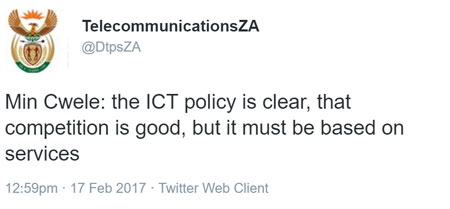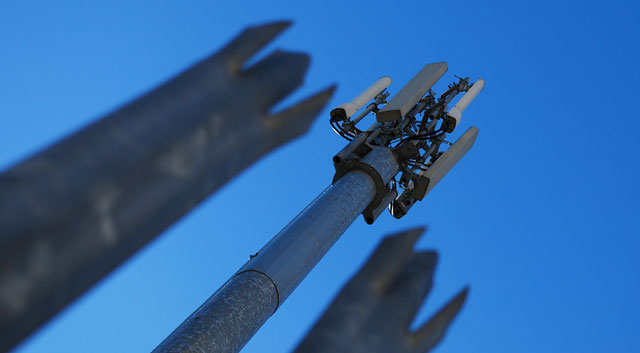 There is a prevailing view in government — or certainly in the department of telecommunications & postal services — that infrastructure competition in providing broadband is bad.
There is a prevailing view in government — or certainly in the department of telecommunications & postal services — that infrastructure competition in providing broadband is bad.
Nothing could be further from the truth.
At a meeting on Friday with industry players, telecoms minister Siyabonga Cwele said that government’s national integrated ICT policy white paper — which sets out proposed policy for the ICT sector for the next decade — states clearly that competition is good, but that it must be based on services.
The idea is that infrastructure competition is a waste of money, that duplication of networks makes no sense. In fact, rivalry between infrastructure providers is crucial to ensuring South Africa doesn’t become an also-ran in ICT. It is the building of a single wholesale network to the exclusion of all other models — as proposed in the white paper — that’s the terrible idea, the one that is very likely to cost us dearly as a nation.
Without proper interrogation, the idea of a single national network might appear to make some sort of sense. After all, South Africa is not a rich country: can it afford to duplicate networks? It’s more sensible, advocates of a single network model will argue, for operators to pool their investments, reducing their costs in the process and passing on those benefits to end users. Nice in theory.
But there are a myriad problems with creating a single national network, or Woan (wholesale open-access network) as government calls it.
Firstly, and most obviously, the state, in effect, wants to create a new infrastructure monopoly. Has it not learnt its lesson from the 1990s, when Telkom — granted a legislated monopoly — rode roughshod over both competitors and consumers?
Ah, but government will argue, the Woan is different. It’s open access, meaning (in theory) that anyone can use it, and, anyway, the real need is for competition at the services level rather than at the infrastructure layer.
But what if the Woan — which, in terms of the proposed policy, will get access to all future “high-demand” spectrum assignments — chooses a technology that fails to take off in the rest of the world (remember WiMax, Dr Cwele?). If there are multiple infrastructure providers, other network operators might choose to invest in different technologies. There are then alternatives. The Woan’s failure to invest in the right technology might doom it, but at least it won’t take the whole country down with it.

And then there’s the fact that monopolies — no matter how well-intentioned they might be — are inefficient. Even with multiple shareholders, what incentive will the Woan have to provide access at the lowest cost? Competition keeps prices in check, not regulators. If government expects to keep the Woan’s prices down through regulation, then it should ask the industry how successful Icasa and its predecessor Satra were at keeping Telkom’s prices in check between 1995 and 2005.
I’m not saying that there should be a complete duplication of infrastructure in all cases. It makes no sense, for example, for 10 companies to dig up the same suburb to provide fibre to the home. And having every operator building fibre between Johannesburg and Cape Town is equally nonsensical. But it should be up to the market to decide where duplication makes sense and where it doesn’t. When money is involved, operators will tend to eschew duplication of basic infrastructure like fibre sleeves and phone towers. This is especially true in an environment where margins are under pressure.
A key principle behind the white paper and the proposed Woan is that smaller industry players will be able to invest in infrastructure. This is where the concept makes some sense, provided it’s not done to the exclusion of alternative network infrastructure.
Government, through Icasa, could reserve a chunk of spectrum (by no means all of it) for a multi-shareholder consortium made up of smaller industry players interested in participating (government should not be one of the shareholders).
Such a network could provide the price competition that government is seeking, without damaging the sector through the creation of a new infrastructure monopoly.
Vodacom, MTN, Telkom, Cell C and other interested network operators should still be able to get access to exclusive-use spectrum, but a (reasonable) portion of sub-900MHz (digital dividend) spectrum, and perhaps some spectrum at 2,6GHz (for use in denser urban areas), could be set aside for smaller players outside an expensive spectrum auction process.
Beyond that regulatory “favour”, however, investors in the new network should compete with the big boys on the network’s merits. Too much regulation distorts markets and leads to unintended outcomes. The market, for the most part, should be left to sort itself out.

At the same time, to expand coverage in rural areas, a spectrum auction for the big players should require them to reach certain rural roll-out targets (defined by Icasa and based on a proper study) before they’re allowed to use the newly allocated spectrum in the cities. Germany did this to great effect; there’s no reason to believe it won’t work here.
For the sake of the industry and consumers — and the broader economy — let’s not experiment with an all-or-nothing model that hasn’t been tested successfully anywhere else in the world (oft-quoted examples Mexico and Rwanda have not had demonstrable successes with similar approaches). Monopolies — including the open-access wholesale kind — should be rejected because, in the long term, they will do much more harm than good.
- Duncan McLeod is editor of TechCentral. Find him on Twitter




